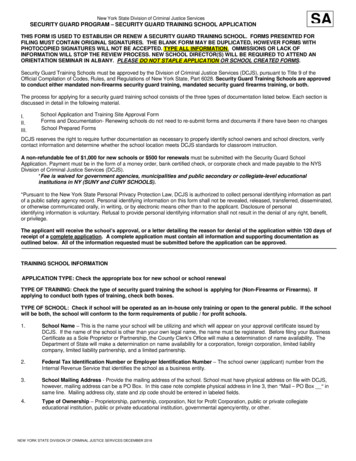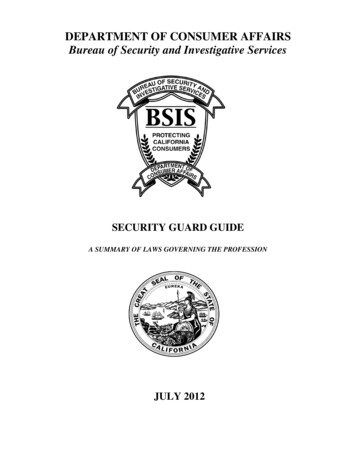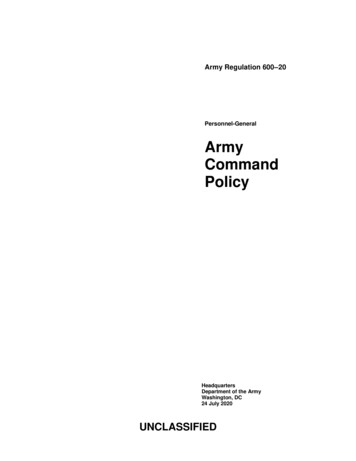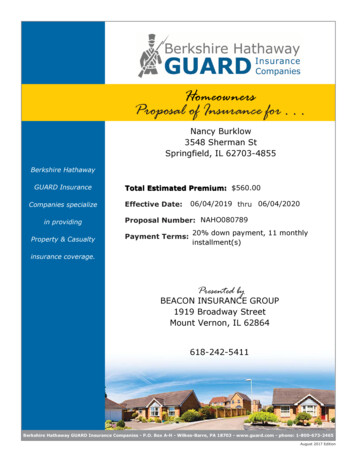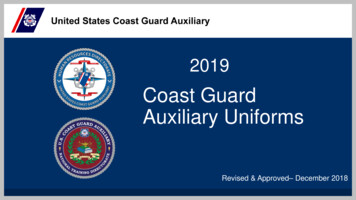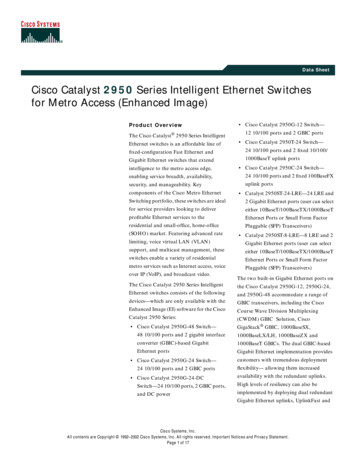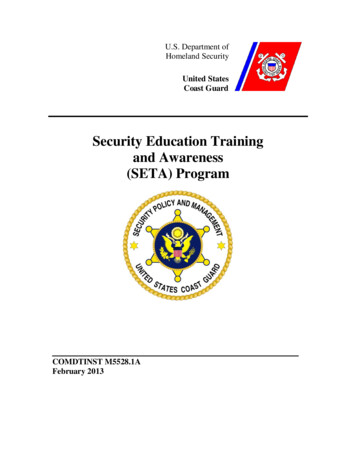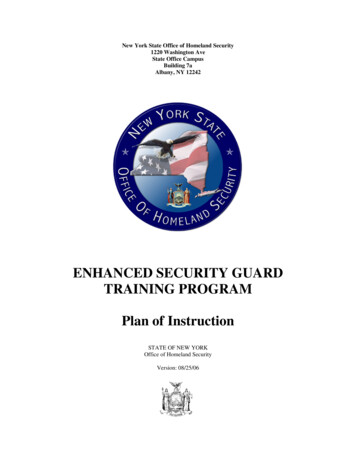
Transcription
New York State Office of Homeland Security1220 Washington AveState Office CampusBuilding 7aAlbany, NY 12242ENHANCED SECURITY GUARDTRAINING PROGRAMPlan of InstructionSTATE OF NEW YORKOffice of Homeland SecurityVersion: 08/25/06
New York State Office of Homeland Security“Deterrence Through Preparedness”PUBLIC SAFETY SENSITIVEThe 2006 edition is published by theNew York StateOffice of Homeland SecurityAlbany, New York 12203VERSION: 08/25/06PRINTED IN THE UNITED STATES OF AMERICANew York State Enhanced Security Guard Training Program, Plan of InstructionVersion: 08/25/062
New York State Office of Homeland Security“Deterrence Through Preparedness”ACKNOWLEDGMENTSGeorge E. PatakiGovernor,State of New YorkJames W. McMahonDirector,NYS Office of Homeland SecurityNew York State Enhanced Security Guard Training Program, Plan of InstructionVersion: 08/25/063
New York State Office of Homeland Security“Deterrence Through Preparedness”ForewordPurpose: The Enhanced Security Guard Training Program is intended to support and complement theexisting security guard training and counter terrorism efforts in New York State by providing training andeducation designed to :(i) improve observation, detection and reporting skillsi;(ii) improve coordination with local police, fire and emergency servicesii;(iii) provide and improve skills in working with advanced security technology includingsurveillance and access control proceduresiii; consisting of instruction(iv) requiring at least forty hours of training including 3 hours of training devoted to terrorismawarenessiv; and(v) has been certified as a qualified program by the state office of homeland securityv.Eighty-five percent of the critical infrastructure in the United States belongs to private enterprise andcorporations. Thus, security guards are literally one of the nation’s first groups of defenders and play anintegral role in prevention and deterrence efforts. Success in prevention and deterrence of both generalcrime, and terrorist acts as well, begins with the establishment of a baseline and maintenance of a robustall-hazards and all-crimes management infrastructure. The professional security guard industry in NewYork State with an excess of 140,000 certified security guards inhabit that baseline. This program willprovide security guards with the basic awareness of terrorism issues that can potentially affectresponsibilities within the purview of their employment. It will improve observation, detection andreporting capabilities while enhancing coordination capability with other emergency responseprofessionals. Additionally, this program will elaborate on previously provided instruction, therebyelevating participants’ familiarity with access control issues and security technology.Topical areas include the following periods of instruction: Information and Intelligence Sharing;Terrorism Indicators and Trends; WMD Standardized Awareness Training; Anti-Surveillance Strategies;Prevention and Physical Security- Vulnerability Assessments; Safety and Security- Emergency Planning;National Incident Management (NIMS) training to include, IS-700 National Incident Management System- An Introduction; and ICS-100 Introduction to Incident Command System (ICS); the Fundamentals ofPatrol; Criminal and Civil Law – Powers and Limitations; Cooperation and Coordination in PublicRelations and Basic First Aid.This program of instruction is consistent with and in recognition of “Homeland Security PresidentialDirective 8: National Preparedness (HSPD-8vi) which call for a National Preparedness Goal thatestablishes measurable priorities, targets, and a common approach to developing needed capabilities.The Goal utilized a Capabilities-Based Planning approach to help answer the questions “how preparedi§ 7. Paragraph (r)subdivision 2 of section 709§ 7. Paragraph (r)subdivision 2 of section 709iii§ 7. Paragraph (r)subdivision 2 of section 709iv§ 7. Paragraph (r)subdivision 2 of section 709v§ 7. Paragraph (r)subdivision 2 of section 709viHomeland Security Presidential Directive 8, December 17, 2003, PresidentGeorge BushiiNew York State Enhanced Security Guard Training Program, Plan of InstructionVersion: 08/25/064
New York State Office of Homeland Security“Deterrence Through Preparedness”are we?” “how prepared do we need to be?” and “how do we prioritize efforts to help answer to closethe gap?” A central objective of Capabilities-Based Planning is the identification of target level ofcapabilities that Federal, State, local, and tribal entities must achieve to perform critical tasks forhomeland security missions. Capabilities are combinations of resources that provide the means toachieve a measurable outcome resulting from performance of one or more critical tasks, underspecified conditions and performance standards. Version 1.0 of the Target Capabilities List (TCL)identifies 36 target capabilities.”viiAdditionally, this program recognizes and is consistent with the Universal Task Listviii (UTL) which“defines what tasks need to be performed by Federal, State, local, and tribal jurisdictions and theprivate sector to prevent, protect against, respond to, and recover from events defined in the NationalPlanning Scenarios” ix in the following areas:CommonPlanning (Training) (All Modules)Prevent Mission AreaInformation Gathering and Sharing, Section 3Terrorism Indicators and Trends, Section 4WMD Standardized Awareness, Section 10Anti-Surveillance Efforts, Section 5Prevention and Physical Security – Vulnerability Assessments, Section 6Fundamentals of Patrol – Access Control, Section 8Fundamentals of Patrol - Communications, Cooperation, and Public Relations; Section 9Protect Mission AreaInformation Gathering and Sharing, Section 3WMD Standardized Awareness, Section 10Prevention and Physical Security – Vulnerability Assessments, Section 6Security and Safety Emergency Planning, Section 7Fundamentals of Patrol – Communications, Cooperation, and Public Relations; Section 9Respond Mission AreaWMD Standardized Awareness, Section 10Security and Emergency Planning, Section 7IS-700 National Incident Management System (NIMS), An Introduction, Section 11ICS-100: Introduction to ICS, Section 12Fundamentals of Patrol – Communications, Cooperation, and Public Relations; Section 9Basic First Aid, Section 13viiU.S. Department of Homeland Security Fact Sheethttp://www.ojp.usdoj.gov/odp/docs/Target Capabilities List 041405.pdfviiiixUniversal Task List, Version 2.1, U.S. Department of Homeland SecurityUniversal Task List, Version 2.1, U.S. Department of Homeland SecurityNew York State Enhanced Security Guard Training Program, Plan of InstructionVersion: 08/25/065
New York State Office of Homeland Security“Deterrence Through Preparedness”In addition to compliance with and guidance obtained from HSPD-8, this program was developed inaccordance with compliance standards of Homeland Security Presidential Directive-5 (HSPD-5)x,Management of Domestic Incidents, so as to ensure standardization and conformity with nationallyaccepted practices and the National Incident Management System (NIMS).Guidance was also obtained from the Office for Domestic Preparedness (Grants and Training),Emergency Responder Guidelinesxi; Awareness Level, as follows:1. Recognize Hazardous Materials Incidents.2. Know the protocols used to detect the potential presence of weapons of mass destruction (WMD)agents or materials.3. Know and follow self-protection measures for WMD events and hazardous materials events.4. Know procedures for protecting a potential crime scene.5. Know and follow agency/organization’s scene security and control procedures for WMD andhazardous materials events.6. Possess and know how to properly use equipment to contact dispatcher or higher authorities toreport information at the scene and to request additional assistance or emergency responsepersonnel.Guidance was also obtained from 29 CFR 1910.120xii OSHA Compliance Regulations as follows:29 CFR 1910.120xiii OSHA Compliance1910.120(q)(6)(i)First responder awareness level. First responders at the awareness level are individuals who are likely towitness or discover a hazardous substance release and who have been trained to initiate an emergencyresponse sequence by notifying the proper authorities of the release. They would take no further actionbeyond notifying the authorities of the release.Guidance was also obtained from the Office for Domestic Preparedness (Grants and Training),Prevention and Deterrence Guidelines; June 2003I.Jurisdictions seeking to improve “Collaborations” between and among public and privatesector agencies to prevent WMD terrorism should:1. Recognize that there is a need for prevention act ivies and actions and that prevention iscritical to a jurisdiction’s preparation for terrorism.2. Establish a system, center, or task force to serve as a “clearing house” for all potentiallyrelevant domestically generated terrorism data and information to ensure interpretation andassessment of the data and information.3. Prepare Memorandum of Understanding (MOUs) and formal coordination agreementsbetween appropriate agencies (public and private) describing mechanisms to exchangeinformation regarding vulnerabilities and risks, coordination of responses, and processes tofacilitate information sharing and multi-jurisdictional preemption of terrorist acts or events.4. Use Community-policing initiatives, strategies, and tactics as a basis to identify suspiciousactivities related to terrorism.5. Explicitly develop “social capital” through collaboration between the private sector, lawenforcement and other partners so that data,xHomeland Security Presidential Directive/HSPD-5, February 28, 2003,President George BushxiEmergency Responder Guidelines, Office for Domestic Preparedness, August 1,2002xiiHazardous Waste Operations and Emergency Response, 29 CFR 1910.120xiiiHazardous Waste Operations and Emergency Response, 29 CFR 1910.120New York State Enhanced Security Guard Training Program, Plan of InstructionVersion: 08/25/066
New York State Office of Homeland Security“Deterrence Through Preparedness”information, assistance, and “best practices” may be shared and collaborative processesdeveloped.6. Coordinate Federal, state, and local information, plans and actions for assessments, preventionprocedures, infrastructure protection, and funding priorities to address prevention.7. Establish a regional prevention information command center and coordinate the flow ofinformation (in and out) regarding infrastructure.8. Exercise prevention and collaboration measures.New York State Enhanced Security Guard Training Program, Plan of InstructionVersion: 08/25/067
New York State Office of Homeland Security“Deterrence Through Preparedness”Enhanced Security Guard TrainingProgram of InstructionTable of ContentsPlan of Instruction .Page 9Periods of Instruction .Page 15Section 1 - Course Introduction/Historical Perspectives . .Page 16Section 2 – Criminal and Civil Law .Page 18Section 3 – Information Gathering and Sharing . Page 20Section 4 – Terrorism Indicators and Trends . Page 22Section 5 – Anti-Surveillance Efforts . Page 24Section 6 – Prevention and Physical Security – Vulnerability Assessment Awareness . Page 26Section 7 – Security and Safety Emergency Planning. .Page 28Section 8 – Fundamentals of Patrol – Access Control Page 30Section 9 – Fundamentals of Patrol – Communications, Cooperation, and Public Relations . Page 32Section 10 – WMD Standardized Awareness . . . .Page 34Section 11 – IS-700 National Incident Management System (NIMS) An Introduction. .Page 37Section 12 – ICS-100: Introduction to ICS . .Page 39Section 13 - Basic First Aid .Page 41Appendices . Page 43New York State Enhanced Security Guard Training Program, Plan of InstructionVersion: 08/25/068
New York State Office of Homeland Security“Deterrence Through Preparedness”Enhanced Security Guard Training ProgramPlan of InstructionGoals:The Enhanced Security Guard Program is intended to support and complement the current security guardtraining and counter terrorism efforts in the State of New York. Through this program, security guardswill gain an increased level of training and knowledge pertaining to security concerns and terrorismrelated issues in support of their role as security specialists and the responsibilities inherent within thepurview of their profession.Cognitive Goal: To provide participants with the basic knowledge and capability to detect and discernpotential criminal and terrorist related activities through a cohesive industry-wide effort, promoting arobust environment of prevention and deterrence.Affective Goal: To provide participants with an appreciation for the complexity and enormity of criminaland terrorism-related activities, as well as an awareness of on-going counter terrorism efforts on local, astate and national level.General Course Learning Objectives:Per § 7. Paragraph (r) subdivision 2 of section 709, The Enhanced Security Guard Program is intended toprovide attendees with the training and skills necessary to:(i) improve observation, detection and reporting skills;(ii) improve coordination with local police, fire and emergency services;(iii) provide and improve skills in working with advanced security technology includingsurveillance and access control procedures;and will have attended training:(iv) requiring at least forty hours of training including 3 hours of training devoted to terrorismawareness; and(v) has been certified as a qualified program by the state office of homeland security.Target Audience: New York State “certified” Security Guard professionals and or supervisory ormanagement staff of a certified Security Guard Agency.Basic Characteristics:As it relates to the General Business Law §89-f (part 6) of the Security Guard Act:“Security Guard” shall mean a person, other than a police officer, employed by a security guardcompany to principally perform one or more of the following functions within the state:a.) protection of individuals and/or property from harm, theft or other unlawful activity;b.) deterrence, observation, detection and/or reporting of incidents in order to prevent anyunlawful or unauthorized activity including but not limited to unlawful or unauthorizedintrusion or entry, larceny, vandalism, abuse, arson or trespass on property;New York State Enhanced Security Guard Training Program, Plan of InstructionVersion: 08/25/069
New York State Office of Homeland Security“Deterrence Through Preparedness”c.) street patrol service;d.) response to but not installation or service of a security system alarm installed and/or used toprevent or detect unauthorized intrusion, robbery, burglary, theft, pilferage and other lossesand/or to maintain security of a protected premises.Provided, however, that a security guard who is otherwise subject to regulation with respect toregistration and training by the federal government in the performance of their duties, or a security guardproviding such services on a voluntary basis, shall not be subject to the provisions of this articlexiv.The role of a security guard professional is to provide his/her client/employer with professional protectiveservices and is dedicated to the principle of maintaining order and security within the area of his/hercontrol. A security guard must be firm but fair and cognizant that his/her actions are geared to the safetyof people and their property. The primary responsibility of a security guard is to protect persons and/orproperty from harm.Target Audience Needs:Because eighty-five percent of the critical infrastructures in the United States belong to private enterpriseand corporations and due to the current world environment with terrorist activity so highly publicized, itis essential that the security guard industry be a knowledgeable component in our prevention anddeterrence efforts. Therefore, these individuals require the basic knowledge to enable them to discern,recognize and take appropriate action to allow our other enforcement and intervention components to takefurther action. Acquiring the knowledge does not ensure both effective or efficient prevention anddeterrence efforts. This knowledge must be combined not only with appropriate and timely two-waycommunication avenues, but also a central focal point that allows for collection, analysis, and feedback ofinformation. This program will provide that knowledge and capability to access those mechanisms.General Pre-Requisites:All course participants must be Security Guardsxv as applicable to the New York State General Businessand Executive Laws, or supervisory/management/administrative staff within a certified Security GuardAgency.Pre-Requisite Knowledge, Skills and Abilities:The New York State Office of Homeland Security Enhanced Security Guard Training Program is anextension of previously provided training as governed by New York State Law. Therefore, securityguards participating within this course of instruction must have satisfied all previous trainingrequirementsThis course is designed to support and complement counter-terrorism efforts currently underwaythroughout New York State. As such, it provides basic information for professional security guards onTerrorism Trends and Indicators, Information and Intelligence Sharing, Weapons of Mass DestructionAwareness, Anti-Surveillance Efforts, Prevention and Physical Security - Vulnerability Assessments,Emergency Disaster and Contingency Planning (an all-hazards approach), the National IncidentManagement System (IS-700, & ICS 100 ), Access Control, Communications, Criminal and Civil legalissues and Cooperation and Coordination in Public Relationships. The course consists of 13 sectionsxivxv§89-f (part 6) of the Security Guard Act§89-f (part 6) of the Security Guard ActNew York State Enhanced Security Guard Training Program, Plan of InstructionVersion: 08/25/0610
New York State Office of Homeland Security“Deterrence Through Preparedness”surrounding the aforementioned topics given in classroom sessions to be provided in blocks of training asdeemed appropriate to complete with minimal interruption of service. The entire program must becompleted within any time constraint proscribed by law in connection with any intended benefit for ataxpayer.Through this course, security guards will gain a basic terrorism awareness that may potentially affectissues and responsibilities within the purview of their employment. It will improve observation, detectionand reporting skills while enhancing coordination capability with emergency response professionals.Additionally, it is anticipated that access control issues and security technology familiarity on the part ofthe security professional will be enhanced through the completion of this program.Required Text/MaterialsEnhanced Security Guard Instructor Manual (Version 1), New York State Office of Homeland SecurityEnhanced Security Guard Participant Manual (Version 1), New York State Office of Homeland Security(To be retained in ownership by student)The Security Handbook, Second Edition; Purpura, Phillip P. (2003). Burlington M: Elsevier. (To beretained in ownership by student)Jane’s Workplace Security Handbook, First Edition, (Jane’s Information Group) (To be retained inownership by student)IS-700 National Incident Management System (NIMS): An Introduction, (program support /emiweb/IS/is700.asp)ICS-100 Introduction to ICS (program support materials), Federal Emergency Management Agency,Emergency Management Institute – http://training.fema.gov/emiweb/IS/is100.aspNIMS Training Guidelines for FY 2006: IS-700, IS-800, ICS-100-400AWR-160 - WMD Awareness Instructor Manual, U.S. Department of Homeland Security, Office of Stateand Local Government Coordination and Preparedness, National Domestic Preparedness Consortium.AWR-160 - WMD Awareness Student Manual, U.S. Department of Homeland Security, Office of Stateand Local Government Coordination and Preparedness, National Domestic Preparedness Consortium. (Tobe retained in ownership by student)2004 Emergency Response Guidebook, U.S. Department of Transportation, Research and SpecialPrograms Administration, Office of Hazardous Materials and Training. (To be retained in ownership bystudent)ATF Lethal Blast, Isolation, and Evacuation Distances ChartATF Bomb Threat ChecklistFBI Suspicious Package BrochureVIDEO: Surviving the Secondary Device Video; (Department of Justice)VIDEO: Shelter in Place, Know What to Do; (Agrium)New York State Enhanced Security Guard Training Program, Plan of InstructionVersion: 08/25/0611
New York State Office of Homeland Security“Deterrence Through Preparedness”VIDEO: Suicide Bombings: The New Chaos; (International Association of Fire Chiefs)VIDEO: Letter Bomb; New Mexico Tech Video ClipVIDEO: Physical Security, An Ever Changing MissionAmerican Red Cross, American Heart Association (or equivalents) Basic First Aid Student Manual, andthe appropriate and adequate supporting first aid equipment as determined by those agencies.Resource Requirements:NYS OHS Enhanced Security Guard Course Instructional ManualNYS OHS Enhanced Security Guard Course Lesson PlansNYS OHS Enhanced Security Guard Course Student Manual (to be retained in ownership by student)2004 Emergency Response Guidebook (to be retained in ownership by student)Jane’s Workplace Security Handbook (to be retained in ownership by student)AWR 160 WMD Standardized Awareness Instructor and Student Manuals, (student version is to beretained in ownership by student)IS-700 Instructor and Student Manuals (student version is to be retained in ownership by student)ICS-100 Instructor and Student Manuals (student version is to be retained in ownership by student)Participant HandoutsCD Rom Instructional Materials and VideosLaptop/Desktop Computer with the following minimum system requirements: Microsoft Windows XP (Home Edition) or Microsoft Windows 2000 4-M CPU 2.20GHz 512 megabytes of RAM DVD Player CD Rom Drive Windows Media Player 10 External computer speaker port for sound amplification of video segments Microsoft Office 2000 Package consisting of MS-Word and PowerPoint Adobe Reader 7.0.5External computer speaker system for sound amplification of video segmentsLCD ProjectorWhite Board/Flip ChartsProgram EvaluationsStudent EvaluationsAttendance RostersCertified Security Guard Schools participating in this program must have access to the internet todownload FEMA study materials for Sections 11, and 12, regarding National Incident ManagementSystem and ICS courses. Electronic submission of a security guard’s final exam must be accomplished byparticipating schools to validate and certify the participant’s study and partaking of the exam.Arrangements for participation in a Basic First Aid course entail several options and potential resourcerequirements to fulfill instruction by a Certified Security Guard School are enclosed in a separatedocument which is attached as Appendix A.New York State Enhanced Security Guard Training Program, Plan of InstructionVersion: 08/25/0612
New York State Office of Homeland Security“Deterrence Through Preparedness”Course StructureMethods of nceEvaluationGeneral/Overall Learning and Performance Objectives:Upon completion of this program the attendee as directed by § 7. Paragraph (r)subdivision 2 of section709 will have achieved and be able to:(i) improve observation, detection and reporting skills;(ii) improve coordination with local police, fire and emergency services;(iii) provide and improve skills in working with advanced security technology includingsurveillance and access control procedures;And will have attended training:(iv) requiring at least forty hours of training including 3 hours of training devoted to terrorismawareness; and(v) has been certified as a qualified program by the state office of homeland security.Additionally participants will be able to:a. identify/list information sharing strategies available within NYSb. identify/list communication avenues within NYS to report suspicious or potential criminal orterrorist related activityc. distinguish/explain the difference between information and intelligenced. describe/explain common methods of operation of terrorist groupse. describe/explain potential indicators of a suicide/homicide bomb attackf. describe/explain the importance of pre-operational surveillanceg. describe/explain the methods utilized to protect critical infrastructure and key assetsh. describe/explain what Risk and Vulnerability Assessments arei. describe and explain the purpose of the National Incident Management System NIMSj. describe and explain basic Incident Command System (ICS)k. describe in detail the importance of Access Controll. identify and list local resources available to professional security personnel for informationresources and supportDiscussion Material: As events that may impact the role of security specialists are capricious and mayshift on a frequent basis, discussion will be generated on a daily basis (where appropriate), consistent withcurrent events to aid attendees in better understanding their evolving role as security specialists.New York State Enhanced Security Guard Training Program, Plan of InstructionVersion: 08/25/0613
New York State Office of Homeland Security“Deterrence Through Preparedness”Participant Evaluation and Responsibilities:Participant’s successful achievement of goals will be evaluated through a combination of psychomotor,cognitive, and affective evaluation consistent with the desired learning outcome of each individual sectionand or module.Additionally participants will be required to complete course evaluations consistent with Kirkpatrick’sfour-level modelxvi of evaluation (level one – reaction), and student evaluations that focus on: The participant’s knowledge at the beginning of this program;The participant’s knowledge at the conclusion of this program;The value of the materials, information and knowledge conveyed during this instruction; andThe relevance of the instruction in relation to the participant’s duties and responsibilities at aspecified work location.Participant Requirements:All course participants must be Security Guardsxvii as defined in the New York State General Businessand Executive Laws or management/staff members working within, for, or with a licensed security entity.The New York State Office of Homeland Security Enhanced Security Guard Training Program is anextension of previously provided training as governed by New York State Law. Therefore, securityguards participating within this course of instruction must have satisfactorily completed all necessarytraining requirements.xviKirkpatrick, D.L. (1994). Evaluating training programs: the four levels,San Francisco, CA: Berrett-Koehlerxvii§89-f (part 6) of the Security Guard ActNew York State Enhanced Security Guard Training Program, Plan of InstructionVersion: 08/25/0614
New York State Office of Homeland Security“Deterrence Through Preparedness”ENHANCED SECURITY GUARDTRAINING PROGRAMPeriods of InstructionSections 1 - 13PUBLIC SAFETY SENSITIVENew York State Enhanced Security Guard Training Program, Plan of InstructionVersion: 08/25/0615
New York State Office of Homeland Security“Deterrence Through Preparedness”Section One: Introduction: Historical Perspectives1.5 HoursThis section provides participants with a review of the development of the security guard profession inAmerica and the evolving responsibilities and challenges facing today’s security professional.TCL/UTL Mission Area:Common (Training)Emergency Responder Guidelines; Awareness Level: N/APrevention and Deterrence Guidelines: N/ATerminal Learning Objectives: Upon completion of this section the participant will be able to describe evolving challenges andresponsibilities facing today’s security professional in light of the profession’s history.Enabling Learning Objectives: Upon completion of this section the participant will be able to:1. Discuss and describe the evolution of security in America2. Describe/Explain the growth of private security companies in America3. Describe/list the evolving challenges and responsibilities facing today’s security professionalRequired Reading: Enhanced Security Guard Student Manual, (Version 1), New York State Office ofHomeland SecurityThe Security Handbook, Second Edition; Purpura, Phillip P. (2003). Burlington M: ElsevierAssignment: The Security Handbook, Second Edition: Chapter 1, pages 3 - 20; NYS Enhanced SecurityGuard Student Manual: Section 1.Participant Feedback:Participants will be required to complete an evaluation that focuses on The participant’s knowledge at the beginning of this period of instruction; The participant’s knowledge at the conclusion of this period of instruction; The value of the materials, information and knowledge conveyed during thisinstruction; The relevance of the instruction in relation to the participant’s duties and responsibilitiesat a specified work location.Instructional Resources Required: Enhanced Security Guard Instructor Manual Enhanced Security Guard Student Manuals The Security Handbook, Second Edition; Purpura, Phillip P. (2003) Laptop or Desktop Computer External Co
The Enhanced Security Guard Program is intended to support and complement the current security guard training and counter terrorism efforts in the State of New York. Through this program, security guards will gain an increased level of training and knowledge perta
